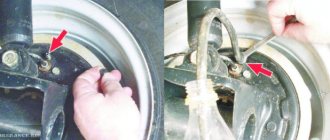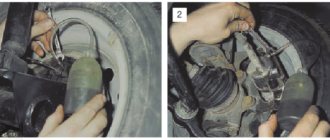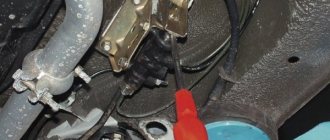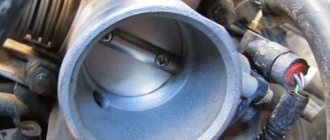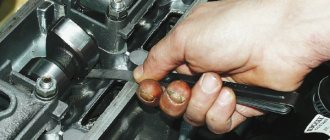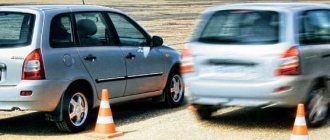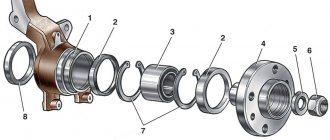It is necessary to bleed the hydraulic brake system circuit after any depressurization caused by repair or replacement of brake cylinders, hoses, tubes, force regulator (sorcerer) or GTZ. Bleeding may also be required after the brakes overheat and fluid boils in the cylinders. Bleed the brake circuit to remove air pockets.
If you trust the experts to bleed the brakes of a VAZ 2110, the price they will charge you will be about 1,000 rubles.
It only includes pumping, and if you do the repair/replacement of the damaged unit directly at a service station, you will have to pay many times more. So, when performing such work yourself, you definitely need to know the pumping procedure, the scheme and what needs to be done in a particular case.
What to prepare for bleeding the brakes of a VAZ 2110/2111/2112
Bleeding VAZ 2110/2111/2112 brakes begins with preparing tools and materials. So, you will need:
- jack;
- a 17mm wheel wrench or a powerful wrench with such a head for removing wheels;
- wrench for 8 or 10 (depending on the type of fittings installed);
- a flat-head screwdriver or a thin mounting blade (when working on a lift);
- a thin transparent hose (for example, from a medical dropper), it is exactly equal to the diameter of the fitting;
- container for expressing liquid;
- bottle of DOT-4 brake fluid.
This set is usually enough to bleed the brakes of a VAZ 2110, the injector is 16 valves or 8, the year of manufacture of the car does not matter. Only the bleeder fittings can differ, which come with an 8 or 10 wrench. It is not advisable to use an open-end wrench to unscrew them, as it licks the edges. It is better to take a special clamping wrench with a screw, and if it is not available, a socket wrench, or a deep 8 or 10 socket with a knob.
Before bleeding the brakes on a VAZ 2110, it is advisable to buy 1-2 liters of new brake fluid; it is not recommended to use an old one or mix two fluids.
This can't be done
There is one very important point regarding brake fluid. You should pay special attention to it, since it will be difficult to predict the result if the recommendations are violated.
Do not mix different types of brake fluid. If you simply need to add it to an existing one, choose only the one that was filled in earlier. Mixing fuel fluids from different manufacturers can lead to unpredictable consequences.
If you need to top up, but you don’t know what kind of fuel fluid is currently there, there is only one way out - a complete replacement of the brake fluid.
Procedure for pumping brakes on a VAZ 2110: work plan
To properly bleed the brakes on a VAZ 2110, the car must be placed on a solid and level surface. If you don’t do this, you won’t be able to accurately monitor the liquid level in the tank and you can avoid airing the system when pumping it yourself when it’s inconvenient for one to control the level in the tank.
The order of bleeding the VAZ 2110 brakes is determined by the location of the circuits. First one swings, then the other. For front-wheel drive VAZs without ABS, the pumping scheme is standard - you need to start from the farthest point.
Sequence of pumping brakes VAZ 2110
Scheme for pumping brakes on a VAZ 2110
On VAZ-2110, 2111, 2112 the circuits are connected diagonally (right front - left rear, and vice versa). Therefore, the procedure for bleeding the VAZ 2110 brakes will be as follows:
- Rear right wheel.
- Front left wheel.
- Rear left wheel.
- Front right wheel.
In order to pump the rear brakes of a VAZ 2110 using a lift according to all the rules, before carrying out the procedure you need to fix the brake force regulator (sorcerer). It is located near the left rear wheel. The sorcerer is locked by installing a flat screwdriver or thin mounting blade between its piston rod and the thrust plate. If you are doing it in a pit, then you don’t need to do this!
You only need to block the sorcerer if the rear axle is hanging in the air. In this position, the beam stops putting pressure on the regulator. As a result, a situation with over-braking of the rear is simulated; if the sorcerer is not supported, the brake lines of the rear wheels are blocked to unlock them. If they do not hang and the beam presses on the sorcerer, it is open, the rear brakes then pump normally.
Bleeding the brakes of a VAZ 2110: order with the sorcerer
VAZ 2110 – bleeding the brakes, the video is shown using Kalina as an example, but the system is the same type. The fact that there is no sorcerer here does not bother you either; on cars equipped with an ABS system, its function is performed by electronics
Correct bleeding of the VAZ 2110 brakes is carried out with an assistant in this order:
- Open the hood, disconnect the fuel level sensor chip.
- Remove the plug from the GTZ reservoir and add fluid to the maximum.
- Lock the brake force regulator (sorcerer) if work is carried out on a lift.
- Remove the wheel whose brakes will be pumped if work is carried out without a lift or pit.
- Remove the rubber cap from the brake cylinder bleeder fitting and place a transparent tube on it.
- Place a container to collect excess liquid, pour some liquid into it and dip the end of the hose into it.
- Ask an assistant to create maximum pressure in the hydraulic circuit by pumping the brake pedal all the way 5-10 times (with pauses of 1-3 seconds between presses), then holding it depressed.
- Unscrew the fitting with a wrench, old fluid with bubbles should come out, and when it stops flowing, screw it back.
When tightening the fitting, the assistant must continue to hold the pedal depressed so as not to create a vacuum in the circuit. - Ask an assistant to release the brake pedal.
- Check the fuel fluid level in the tank; if it drops below the minimum, top it up.
- Repeat steps 7 to 10 until the flow of fuel fluid from the fitting is smooth, clean and free of bubbles.
- Tighten the fitting, put a cap on it, wipe the parts from liquid leaks, put the wheel in place and tighten it.
- Remove the other wheels one by one and bleed the brakes on the VAZ 2110, the procedure is described above.
When it is necessary?
As a rule, if all brake components are in good working order and the brake fluid paths are sealed, then they do not require any bleeding. But if a fuel fluid leak occurs due to damage to the “overpasses” and a drop in its level, both brake repair and mandatory bleeding will be required.
This is a vitally necessary procedure, because airiness in the system can lead to the fact that at the very moment when everything is decided by seconds, the brakes will not work. And there will be nothing left to pump, and no one...
Therefore, let’s take care of this immediately, if we find that the brake pedal has increased travel, it has begun to “go limp,” as car enthusiasts say – the brakes are “wobbly.”
Hydraulic brake circuit diagram
In addition, there are other reasons why pumping is necessary:
- You had to interfere with the operation of the system;
- There were cracks in the hoses, leaks of fuel fluid;
- The brake fluid turned out to be of poor quality and needs to be completely changed;
- Have you changed the brake discs (sooner or later this needs to be done);
- The water content in the fuel fluid has increased (it is hygroscopic, i.e. it absorbs and accumulates water), so it sometimes has to be changed.
How to properly bleed the brakes on a VAZ 2110 yourself
Some motorists recommend bleeding the brakes alone, pumping and supporting the pressed pedal with a board/pipe/pry bar/bat/other oblong object, but this is not the most convenient option. If there is no assistant, it is better to use a gas lift of a suitable length instead, having a working force of 100 newtons. He will press the pedal as soon as the fitting opens, and thereby prevent the creation of a vacuum in the circuit.
Self-bleeding the brakes of a VAZ 2110, 8 valves or 16 – it doesn’t matter (as well as the type of power supply, carburetor or injector), is available in three ways:
- exposure to pressure;
- exposure to rarefaction;
- by gravity.
Self-pumping under pressure
On the VAZ 2110, bleeding the brakes under the influence of external pressure is possible using additional equipment. You will need:
A device for bleeding the brakes for one person (a cap with a nipple to create pressure in the system). Can be used as a special device such as a pump, compressor, inflated wheel (chamber)
- compressor, pump or tank with compressed air (a spare tire will do);
- air supply hose;
- nipple for tubeless wheel;
- TZ tank cap without sensor (from Zhiguli);
- drill of a diameter corresponding to the fitting diameter of the nipple.
Before you bleed the brakes on a VAZ 2110 yourself, you need to take the reservoir cap and drill a hole in it. The nipple should be inserted into it so that it sits there tightly. This cap must be screwed onto the GTZ tank, after adding fluid to the maximum. Then you need:
- Get to the brake fitting, remove the cap from it, put on a 8 or 10 key and a hose, immersing its end in a container (as described above).
- Connect the air supply hose to the nipple in the reservoir cap.
- Apply pressure to the tank through the nipple by pressing the compressor gun, pumping the pump or putting the hose on the spare tire.
- Unscrew the fitting to bleed air bubbles from the brake circuit.
- Wait until the fuel fluid flows through the hose in an even stream without bubbles.
- Tighten the fitting and stop the pressure supply.
- Repeat steps 3-6 for the remaining wheels.
Bleeding the brakes with vacuum
Instead of excess pressure, vacuum can be used to bleed the brakes of the VAZ 2110. To do this, you will need a large syringe (from 100 cubic meters) and a hose to connect it to the fitting. The procedure is as follows:
- Open the reservoir on the GTZ and fill in the maximum amount of liquid.
- Place the key on the fitting and connect the fitting to the syringe with a hose.
- Open the fitting and pull the syringe plunger towards you, creating a vacuum in the brake circuit.
- After filling the syringe, close the fitting and drain the fuel fluid into the container.
- Repeat the manipulations from steps 2-4 until the liquid begins to flow into the syringe in an even stream without bubbles.
- Repeat steps 2-5 for all wheels, following the order of bleeding the VAZ 2110 brakes.
This method is less efficient and consumes more fuel fluid, so it is used when pumping with pressure is not possible. It should be remembered that it is not worth reusing the pumped-out fuel fluid, due to the presence of contaminants from the circuit and atmospheric moisture in it.
Bleeding VAZ 2110 brakes by gravity
Bleeding brakes 2110 by gravity is the simplest, but most expensive method in terms of using brake fluid. All you need is hoses, drainage containers and a DOT-4 bottle. Pumping is carried out in this order:
A dropper with which it is convenient to bleed the brakes yourself
- Open the GTZ tank.
- Place the hoses on the fittings and insert their free ends into the containers under the drain.
- Unscrew the fittings on the brake cylinders.
- Start pouring fresh fuel oil into the GTZ tank, while simultaneously observing the streams from the fittings.
- When the liquid begins to flow through the hoses smoothly and without bubbles, tighten the bleeder fittings one by one.
If, as a result of pumping, the liquid in the tank does not reach the Max level, you need to top it up. If there is too much TJ, the excess must be pumped out with a syringe. It is not recommended to reuse the fuel fluid drained from the fittings; it must be disposed of.
How to bleed the brakes of a VAZ 2110 without removing the wheels
It is not necessary to remove the wheels to bleed the brake system. This is necessary to facilitate access to the fittings, but you can do without this item if:
- drive the car into a pit or overpass;
- raise it on a lift;
- use a high jack.
Since you can pump the front brakes on a VAZ 2110 purely by turning them out, this operation can be performed on any flat surface. To access the fitting for the left wheel, you need to turn the steering wheel all the way to the right, and for the right wheel, turn it all the way to the left. The gap between the wheel and the arch will be quite enough.
A pit, overpass or lift is needed to access the rear wheel fittings. You can use a jack to raise the rear end and straighten the strut spring to its highest position. The wheel will lower relative to the arch and the resulting gap will be enough to reach the fitting by hand. But since it is more convenient to unscrew 4 bolts, it is better not to “reinvent the wheel” and pump the brakes by removing the wheel.
How to bleed the brakes on a VAZ-2110 if the fitting is broken
If the fitting cannot be unscrewed, screw in the fitting and the hose on top. This will allow air and old fluid to bleed off.
If the bleeder fitting is broken or the edges of the key are hopelessly licked, you need to unscrew it using an extractor or drill it with a 6 mm drill, and then install a new one. If the old one had to be removed by drilling, you need to cut an M10 thread and install a fitting under it (for example, from a Gazelle).
To bleed the brakes on a VAZ 2110, if the fitting is broken, you can use the connecting fitting (fitting) of the brake cylinder with a pipe. The procedure will be exactly the same as for normal pumping (described above), but instead of a fitting you need to unscrew a tube or hose .
Partial bleeding after replacing the brake cylinder
The repair manual recommends replacing brake parts in pairs on both sides so that the braking forces on the wheels of the same axle are equal. But if only one element of the braking system was repaired or replaced, and the level of fuel fluid in the tank did not fall below the minimum, it is permissible to limit oneself to de-airing one circuit. In this case, bleeding the VAZ 2110 brakes after replacing the brake cylinder is only possible for the rear right and front left or rear left and front right wheels.
If the level of fuel fluid in the tank drops to the bottom as a result of a breakdown or repair, it will not be possible to limit yourself to pumping one circuit. After all, there is a great risk that all 4 tubes managed to pick up bubbles. Since it is impossible to bleed the rear brakes on a VAZ 2110 without the front ones due to the diagonal connection of the circuits, when replacing cylinders or tubes in pairs on one axle, a complete de-airing procedure is required. Likewise, bleeding the front brakes of a VAZ 2110 without the rear ones is unacceptable.
Tubes to GTZ
Where does the air in the brakes come from?
Untimely maintenance and inattention to the technical condition of the machine are not all the reasons why air problems occur. Let's consider several main reasons for the violation of the tightness of all circuits:
- Replacing technical fluid throughout the entire circuit involves draining the old DOT4. At the moment of refilling, air also enters the circuit;
- There are hoses going to the brake cylinder, damage to which is a very common situation on VAZ. Over time, they begin to “sweat” and become airy;
- Cylinder leaks (both rear and front);
- Leak from the GTZ.
Timely maintenance involves replacing all fluids in the car, incl. and brake. Ignoring this fact plays a cruel joke on drivers. With long runs, moisture somehow gets into the system, which reduces the resistance of DOT4 to low temperatures. In cold weather, the pipes can crack and render the machine stopping unit unusable. Also, do not allow DOT4 to come into contact with paint surfaces. It contains quite aggressive elements that can damage the paint. If you carry out manipulations yourself, using a compressor to pump up pressure, follow the safety rules. Excessive pressure will cause the pipes to rupture and spill their contents onto you. After completing the work, do not rush to accelerate and check the effectiveness of the brakes at high speed. It is enough to press the pedal several times and feel how much it sinks. In a situation where following the instructions does not produce results, contact the service specialists. It is better to pay for brake system repairs with money than with your safety.
How to bleed the main brake cylinder on a VAZ 2110
Bleeding the GTZ on a VAZ 2110 is carried out using the same methods as for wheel brake cylinders. But since in this case the fuel fluid must be replaced with a new one, preferably before pumping:
- Open the fittings.
- Blow out all the main pipes one by one with a compressor or pump to expel the remnants of the old fuel oil.
- Install the GTZ and attach the tubes to it.
- Bleed the brakes of the VAZ 2110, following one of the instructions above.
In addition to getting rid of the remnants of old fluid, purging the lines allows you to clear them of deposits. For maximum cleaning effect, you can disconnect the tubes from the cylinders and blow them out in this position. This will prevent contaminants from getting into the brake cylinders from the pipes.
KAMAZ brake pads, installation and replacement
Installation of brake pads KAMAZ
How to properly install KAMAZ pads
KamAZ. How to rivet KamAZ pads.
how to rivet linings on Kamaz brake pads
I'm assembling a Kamaz for myself. Front brakes. (way out)
Adjusting Kamaz brakes
How to install brake ratchets on Kamaz, MAZ, ZIL
KAMAZ hub, replacing bearings, oil seals, knuckle bushings, riveting and installing pads
How to rivet brake pad linings
KB-60: CHPEK 1.2 – Riveting of truck brake pads
Riveting and installation of brake pads.
